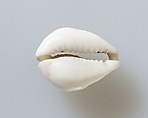Cowrie shell
Ptolemaic Period
Cowries are known from the very earliest times in Egypt, but this shell - from a Ptolemaic burial at Akhmim - testifies to their continued significance through the millennia. The shell was found next to the head of a male mummy adorned with cartonnage ornaments and inside a wooden coffin. The back of the shell has been ground away, so that the shell can lie flat when strung so possibly it was originally worn as a diadem or necklace.
Cowrie shells, originating usually from the Red Sea, were widely valued as amulets in the ancient world. Their resemblance to the female vulva and alternatively to a squinting eye is thought to underlie a magical association with fertility and with protection from the evil eye, respectively. Generally they are known from female burials in Egypt, but they can also accompany males.
This image cannot be enlarged, viewed at full screen, or downloaded.
This artwork is meant to be viewed from right to left. Scroll left to view more.



